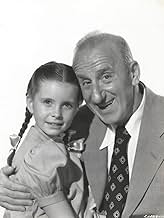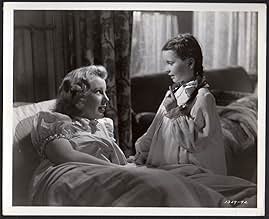Six year old "Mike" joins her sister Barbara Ainsworth who plays in a classical orchestra during WW II.Six year old "Mike" joins her sister Barbara Ainsworth who plays in a classical orchestra during WW II.Six year old "Mike" joins her sister Barbara Ainsworth who plays in a classical orchestra during WW II.
- Nominated for 1 Oscar
- 4 wins & 2 nominations total
Madeleine Lebeau
- Jane
- (as Madeleine LeBeau)
- Director
- Writer
- All cast & crew
- Production, box office & more at IMDbPro
Featured reviews
This is sheer magic. Margaret O'Brien, aged seven, is the perfect pixie. Unlike Shirley Temple, who could be over-sweet, Margaret O'Brien as a child star was too honest and direct ever to be saccharine, and she never catered to an audience at the expense of her character. Although she could doubtless turn tears on for the camera like a true pro, she never compromised her integrity of genuine childlike innocence, the portrayal of which on the screen borders on the supernatural. Although I met her briefly once before, just to say hello to, I knew her for a few days when she was already a young woman. At that time she was wearing an excessive amount of makeup to try to appear 'grown up' and shed the childlike image which was costing her work as an adult. I saw her once with no makeup at all, and was astounded that even when grown up, underneath her disguise, she had exactly the same child's face. She was very shy and difficult to communicate with because of her apparent introversion. It was evident, however, that her ability to portray innocent adorable waifs on the screen was because it was all true deep inside. Matched here with the childlike June Allyson, the pair are real heart-breakers, and the business of Kleenex must have doubled when this film was released towards the end of the War, especially as there is a husband away fighting in the Pacific, which is a thread throughout the story. This film was directed by Henry Koster, best known for 'My Cousin Rachel' in 1952, who on occasion could tease the very best out of actresses. Larry Adler aged 30 is in the film, in a small speaking part, and plays Debussy's 'Clair de la Lune' beautifully. This is after all a film based round music and a symphony orchestra conducted by real-life conductor and pianist Jose Iturbi, who has a prominent part in the story and does very well. It is fascinating to watch his technique of conducting from the piano, where he leaps up and down with a jack-in-the-box. There are many absolutely hilarious moments in this delightful film, some brought about by Jimmy Durante, whose thick accent however becomes less comprehensible with every passing year that takes us further away from those New York days of Damon Runyon which produced him. (Ethnicity is no longer guaranteed to be funny like it was then, either.) This is one of those films where you will either cry because you are crying or cry because you are laughing, but either way, there is no escape. This film is pure delight, an absolute joy. It is guaranteed to cure any case of depression instantly.
Music that covers every genre of the time and a wonderful performance by June Allyson as the expectant war bride who works playing a bass fiddle for Jose Iturbi's orchestra are the main hallmarks of Music For Millions. Of course the big name in the cast for the time is little Margaret O'Brien who was winning hearts all over the USA during the World War II years.
There were numerous films during those years that covered women doing all kinds of work in occupations for men. Why would playing in a symphony orchestra be different. Jose Iturbi is hemorrhaging male musicians in his orchestra to the draft and his ensemble was starting to look like Phil Spitalny's band.
One fine evening Allyson's little sister Margaret O'Brien comes to town and interrupts a concert at Carnegie Hall. Iturbi and orchestra manager Jimmy Durante are put out, but the women in the orchestra really take to O'Brien the way America did. Even Iturbi and Durante come around and Margaret becomes a kind of mascot.
A real crisis erupts when a War Department letter arrives for Allyson, but she doesn't get it courtesy of her fellow musicians. June is pregnant now and the women figure no news is good news until she has the baby. One of June Allyson's best acted scenes is with Iturbi where she confesses how frightened she is not knowing and hoping for the best for her husband out in the Pacific.
Iturbi does some classical music and appropriately the film ends with Handel's Hallelujah Chorus and why appropriate you watch the film for. And Jimmy Durante is his own comic self and his rendition of Umbriago is a film highlight.
Women certainly play in orchestras now. I live around the corner from the Kleinhans Symphony in Buffalo and I see many a female musician parking their cars and carrying their instruments to the hall. And we have a female conductor named Joann Falletta. This review is dedicated to her.
There were numerous films during those years that covered women doing all kinds of work in occupations for men. Why would playing in a symphony orchestra be different. Jose Iturbi is hemorrhaging male musicians in his orchestra to the draft and his ensemble was starting to look like Phil Spitalny's band.
One fine evening Allyson's little sister Margaret O'Brien comes to town and interrupts a concert at Carnegie Hall. Iturbi and orchestra manager Jimmy Durante are put out, but the women in the orchestra really take to O'Brien the way America did. Even Iturbi and Durante come around and Margaret becomes a kind of mascot.
A real crisis erupts when a War Department letter arrives for Allyson, but she doesn't get it courtesy of her fellow musicians. June is pregnant now and the women figure no news is good news until she has the baby. One of June Allyson's best acted scenes is with Iturbi where she confesses how frightened she is not knowing and hoping for the best for her husband out in the Pacific.
Iturbi does some classical music and appropriately the film ends with Handel's Hallelujah Chorus and why appropriate you watch the film for. And Jimmy Durante is his own comic self and his rendition of Umbriago is a film highlight.
Women certainly play in orchestras now. I live around the corner from the Kleinhans Symphony in Buffalo and I see many a female musician parking their cars and carrying their instruments to the hall. And we have a female conductor named Joann Falletta. This review is dedicated to her.
10dickmass
This little movie is a warm, loving, funny movie full of hope and faith from a 7 year old child in a time of World War. They don't make them like this any more, plain acting NO special effects. You can't find it on any type of video, though I can't imagine why, with all the trash being brought out today. If you can catch it on one of the movie channels DO NOT MISS IT; grab something warm to drink and some tissues.
10marshakt
The music is worth the viewing of this WWII film. Jose Iturbi performs some classic pieces as only he could do. This movie gives a slice of life from a different era. Some of the funniest scenes are between Jimmy Durante and Margaret O'Brien. June Allyson's scenes with Marsha Hunt compel even the most cynical person to tears. Seeing tiny June Allyson playing the huge double bass (not the cello) has its own kind of humor, and interestingly, the main character of the movie doesn't appear on screen! But it is the music that makes the film so sweet and memorable. The music is as much a part of the story as the characters. It was a time of innocence and sweetness that June Allyson and Margaret O'Brien capture so perfectly. They don't make movies like this any more.
This is a wonderful movie, where the trauma from a war, which invades all countries during all wars, is seen through the eyes of a child. A brilliant actress, Margaret O'Brien, takes viewers through the torment of WWII, praying for the safe return of her sister's husband. I taped this movie when it played on TCM, and I've watched it many times, because it sends multiple hidden messages to those who watch with wisdom. The movie exposes a woman's fear of losing the father of the fetus in her womb. That fear is something that people continue to experience in today's world. Adults in the movie learn from the wisdom of the little girl, Mike, who helps her sister during this struggle. During WWII the music in this movie was marvelous for millions; it's quite inspiring to viewers today, as well.
Did you know
- TriviaIn a scene in which June Allyson and Margaret O'Brien were supposed to cry to harmonica player Larry Adler's rendition of "Clair de Lune," the six year-old star asked director Henry Koster, "Shall I let the tears run all the way down my face, or shall I stop then halfway down?"
- Crazy creditsAfter "The End," the following message is seen: "To families and friends of servicemen and women: Pictures exhibited in this theatre are given to the armed forces for showing in combat areas around the world---War Activities Committee, Motion Picture Industry."
- ConnectionsReferenced in Top Secret ! (1984)
- SoundtracksClair de Lune
(1890) (uncredited)
Written by Claude Debussy
Performed by Larry Adler on harmonica
Also performed by José Iturbi on piano
Details
Box office
- Budget
- $1,744,000 (estimated)
- Runtime
- 1h 57m(117 min)
- Color
- Aspect ratio
- 1.37 : 1
Contribute to this page
Suggest an edit or add missing content


































